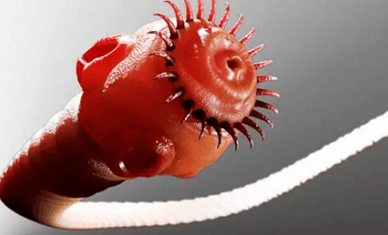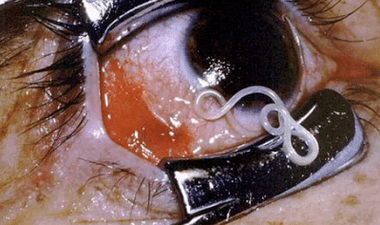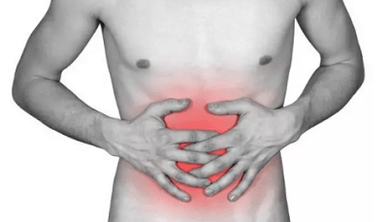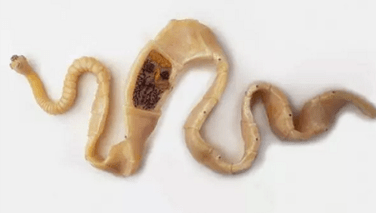Every modern person at least in his life has found parasites in the body.The quantity and various parasites, which, in a literal sense, cannot live without us, are just big.Parasites in the human body use it as a source of food and habitat so that they are truly dispose of it, but without giving their presence.
Parasites are microscopic size or can grow up to a few meters long, but even in this case, their important activity in the body cannot be felt.A person, as a rule, does not feel them and does not know about their presence in himself.In the meantime, they have been able to live in the human body for years and even decades, causing him to be improved.
Parasites in the human body pose a serious danger and pose a significant threat to human health, as they violate the functioning of the internal organs and systems, pose a failure in the work of the immune system and interfere with the complete assimilation of useful substances, vitamins and minerals.In some cases, the situation is so serious that it can cause death.
The type of relationship between organisms
Naturally, there are several types of relationships between organisms that have a variety of effects on each other.
The effect of one species can have both neutral or positive, and negative.
In addition, there are different combinations of relationships.Distinguish:
- symbiosis;
- neutralism;
- antibiosis.
Symbiosis is a form of relationship between two organisms, from which the two are beneficial.
Neutralism is a biological connection, consisting of the population of two organisms in one region, but at the same time they are not related to each other and not directly affect each other.
Antibiism is a type of antagonistic biological relationship in which one type of population limits the possibility of another, affecting it.One of the most negative types of antibiism is parasitism.
Parasitism and parasites

Parasitism is a form of antibiotics in which representatives of one species use the body of another species as a temporary or fixed environmental environment and a source of nutrients.
Biological organisms living at the expense of other organisms are called parasites.
Parasites do not kill the owner, but for a long time use it as a source of food and habitat.
Parasites include:
- parasitic worms;
- pathogenic bacteria;
- protozoa;
- mushrooms;
- Virus.
The host organism can:
- bacteria;
- protozoa;
- plants;
- animals;
- Humans.
In the development process, parasites approve several stages of development from eggs and larvae to adults (sexually, invasive), which shows their long life and needs to convert 2-3 owners.
Classification of parasites
All parasites are divided into bonds and options.
Looking at the parasites outside the host's body whether they die or exist in an inactive state.For example: virus.They carry an exclusive parasitic lifestyle, that is, they depend entirely on the owner and activate their activities in it.
Optional parasites carry the parasite lifestyle, but if necessary, it can exist in the true form of normal in the external environment.For example: pathogen and bacterial mushrooms.
With the nature of the relationship with the host body, they share:
- True parasites;
- fake parasites;
- Super parasites.
True parasites are the same bond parasites where parasite lifestyle is one form of survival.However, there are parasites that can be either (fixed) and temporal (temporal).For example: lice, fleas, intestinal helminths.
False parasites - voluntary living organisms, which, if they accidentally enter the body, can live in it for some time and harm them.For example: the larvae of the room flying in one's intestines.
Super parasites are parasites that live in other parasites.For example: bacteria and viruses in other parasite insects that live in other organisms.

Depending on the duration of interaction with the host body, they distinguish:
- constant parasites;
- Temporary parasites.
Persistent parasites are organisms that run their life cycle in the body - owners, putting the larvae in it.For example: ascarides, tape worms, lice.
Temporary parasites;Live and eat at the expense of the owner at a certain level of development.For example: Volt-G-Cart flying larvae and Imago (adult insects)-in lice and mosquitoes.
At the location of the host body, the parasite is divided into:
- ectoparasites;
- Endoparasites.
Ectoparasites are organisms that live on the skin of the host body.For example: lice, fleas, fleas.
Endoparasit is an organism located in the host body.Endoparasit is divided into:
- internal parasites;
- tissue parasites;
- intracellular.
Intra -capture parasites are organisms located in the cavity that connect to the external environment, for example: Ascaris, Vlasov -head in the human intestine.
Fabric-type parasites of organisms located in the cavity and closed tissue of the host body, for example: for example, liver bacon, cystics worm tape.
Intraselular parasites are localized in body cells - owners, for example: malaria plasmodia, toxoplasma.
In terms of environmental distribution, parasites are:
- Curls, found anywhere;
- Tropical, which is only common in hot tropical climate.
According to biological and epidemiological features, parasites are divided into:
- Geogelminters- These are parasites that initially undergo developmental stages in the human body, and then in the external environment (for example, earth);
- Biogelminters- Parasites where the development cycle occurs not only in the human body, but also in other creatures.A person, as a rule, is the final owner, and sometimes in the middle.
- Contact HelminthsThey are distinguished from the host's body with mature or half, the result is possible to repeat other people's infections or infections (autoinasia, Reinvasia).
How parasites fall into the human body
There are many encouraging factors that contribute to the inclusion of parasites into the human body:

- dirty hands;
- animal hair;
- well -cooked products (preventive factors);
- Household Relationship Factors;
- can be transmitted;
- Awareness.
Dirty hands are a major source of infection with parasitosis.There are several diseases called "dirty hand disease."Worm larvae, falling on the first skin, and then in the mouth, causing symptom symptoms from the gastrointestinal tract.The transmission path of this infection is called fecal-oral.Therefore, helminths with helminthiasis relationships fall into our body.For example, ascaride eggs enter the human body through dirty hands, non -washed vegetables, fruits, berries, vegetables, and even spread to flies.
Their animals and feathers are sources of ascaride and liphyli with worms.For example, for a long time, which has fallen from animal hair, maintains a lifestyle (up to 6 months) and, falling on carpets, objects, beds, toys and children's hands, penetrating the food channel.
Also, through wet breathing, dogs and cats can get rid of parasite eggs at 3 - 5 meters.In addition, there are fleas on dogs and cats, which also tolerate worm eggs.
The method of digestive infection with parasites is carried out:
- through vegetables and non -washed fruits;
- well -cooked food (most often meat);
- Infected water.
For example, a badly cooked barbecue, a pig or a homemade can infect a person with trichinellosis and echinococcus, and dried fish or less cooked caviar can cause infections with opisthorchiasis and broad tape.
Transmissive infection methods occur using blood -high insects, for example: lice, mosquitoes, fleas, fleas, bugs.
Contact - Domestic infection roads are carried out through infected people or animals, when contacting or using the same household goods.
The method of infection occurs during bathing in the reservoir or in contact with the infected soil.The larvae penetrates the body through the mucous membranes or human skin during contact with the infected water or soil.
Feature of the device
Almost all parasites are very easy to suit with survival.There are several factors that contribute to their high vitality:
- Long life expectancy.For example, helminths have lived in the human body for years, and sometimes as accurate as the owner of life.
- Helminth eggs can survive and do not collapse in the external environment for decades.
- The level of parasitic development also contributes to its lifespan.It goes beyond all stages of development, starting with the eggs, continuing the larvae and the owner's change, in the event of a lack of nutrients.
- The ability of the parasite to cause immunodeficiency in the owner, which allows you to penetrate the pathogen agent from the outside, as well as "incite" the inactivity of internal infections.
- Helminths falling into a person's gastrointestinal tract produce anti -Enzymes, which allows them to pass their own death, but at the same time they violate the normal process of eating and cause toxic allergic reactions in their hosts: asthma, urticaria, dermatitis.
- Parasitic infertility is associated with the exchange of genetic information during sexual reproduction, leading to the stability of their heterogeneous population.
- The authenticity of helminths in many habitats: soil, water, animals, growing.
- Lack of effective immunoprophylaxis method, as parasites can suppress or change the immune response of the host body.
How to identify parasites in the body

As a rule, one asks such a question when his or her health is truly weakening.It is common for a person to reject the problem in the early stages so that it develops into a serious form and will affect his well -being.
Because parasites are divided by habitats in the body - owners to endoparasites and ectoparasites, symptoms are divided into internal and external.
Ectoparasites are characterized by certain activities, indicated by the following symptoms:
- skin rash;
- itching;
- burning;
- Hyperemia;
- pain (if it bites);
- The presence of wounds in the bite.
Detecting endoparasites is easier.The following actions are carried out for this:
- visual introduction (if there is a penetration from the outside through the skin);
- Microscopic examination.
The discovery of ectoparasites is a difficult task, because in the process of evolution, "dependents" have adapted to survival, while disguising and without betraying themselves, they are doing destructive work on the host's body.After all, someone lives, for example, with worms since their appearance, and their developmental stages can take several months to a decade.So how to determine the presence of parasites in the body?
External and internal manifestations
Because parasites vary in a long life and actively reproduce in the human body, they cause long and chronic symptoms.
External manifestations of parasitic activities include:
- skin rash;
- itching;
- burning;
- Hyperemia;
- fever condition;
- Edema Quincke.
It is important to know that the level of allergic development depends on many factors:
- Location of parasites in the body;
- parasitic relationships with important tissues and organs;
- The amount of toxins produced.
The following symptoms include infringement in the body of internal intrusion:
- disruption in the functioning of the gastrointestinal tract (nausea, diarrhea -birit, belching);
- heavy fluctuations associated with nutrient deficiency and decreased appetite;
- the desire for sugar -gent due to metabolic disorders and general weakness of the body;
- Chronic fatigue syndrome, indicated by general fatigue, drowsiness, in some cases of insomnia, concentration and memory impaired;
- Persistent headaches due to weakness of the body and intoxication;
- Teeth grind in a dream (bruxism), very much shown in children;
- swelling of the limbs;
- Nerve disorders and psychic disorders, as parasites can cause depression and irritation;
- paroxysmal cough;
- muscles and joint pain;
- pale skin pain;
- Skin lesions (dermatitis, eczema, acne and acne).
It is very important to know the general symptoms observed by the intrusion of intestinal parasites.

Violation in the digestive tract, indicated by the following symptoms:
- intestinal cramps;
- colon syndrome;
- bloated;
- constipation or diarrhea;
- Change the color of the stool;
- Itching in the anus;
- Visual detection of helminths;
- The presence of worms in the crow.
Because worms can achieve significant size in the body, they can physically complicate the progress of the stool and violate other organs, for example, bile ducts.
Parasites can cause violations in the work of a particular organ or system.
The most common violation is:
- Anemia.
- Lesions of the central nervous system.
- Abses in the heart.
- Inflammation of the gall bladder and pancreas.
- Fruits in immunity work, until the development of autoimmune reactions.
- Disruption in the operation of the respiratory system.
- A common disease.
Diagnosis of parasites
All of the above symptoms cannot accurately confirm the presence of parasites in the body, as these symptoms can be seen in many diseases.
You can create the presence of parasites in the human body when examining stools.However, this method is not reliable, as parasite larvae cannot be seen through microscope or skip them.In addition, not all parasites lay many eggs.
To detect parasitic larvae in stools, it is necessary to take up to 8-10 times the analysis of stool.But if in this case the analysis does not show anything, but the doctor has doubts, then some serological blood tests are prescribed, which will help detect helminths antibodies that appear in the blood a few weeks after infection with parasites.

There are other methods for identifying the "liability" of the so -called string test.The string with the capsule is inserted into the intestine through the nose and removes it after four hours together -with the sample received.
Another method is colonoscopy where experts consider the colon's internal surface to use a special investigation.
Experts find that the most common parasites are helminths.In addition, they are all very viable and fertile, and their goal is to destroy their master and extract the maximum benefits for themselves.
How to remove parasites from the human body
It's hard to get rid of parasites, but it's possible.It is important to give priority: not only to know how to get rid of parasites, but also to understand what the treatment is.It runs in three directions:
- Destruction of parasites at all levels of existence.That is, it is necessary to destroy not only adults, but also their larvae and eggs.
- Normalization of the work of all organs and systems of the body.
- Recovery.
To meet the three items above will help modern medicine based on plant components that specialists will prescribe.
Such medicines are modern medicine and have certain therapeutic effects.The use of these drugs in the complex allows you to combine their therapeutic effects and get beautiful results.
Dosage and combination of drugs with each other are done based on:
- parasite intrusion stage;
- the general condition of the patient;
- the availability of complications from a particular body;
- The severity of the course of the disease.
Anthelmintic drug priority is based on:
- efficiency;
- safety;
- The possibility of combining several drugs for the best therapeutic effect.
Treatment with folk medicine is a very effective way to get rid of parasites.Often, grass cleansing tea is used, which neutralizes the harmful effects of parasites, cleansing the liver and gall bladder.
They provide tea as follows: Take one tablespoon of the following plants: oak bark, buckthorn, wormwood, tansy.Then, one tablespoon of plant mixture is poured with 500 ml of boiling water and left in a closed meal overnight.In the morning, on an empty stomach, 100 grams of tincture are drunk.Treatment continues for two to three weeks.
Pumpkin seeds are also very effective in combating parasites.To get rid of parasites, 300 grams of pumpkin seeds are taken, they are cleaned from the skin, but at the same time they leave a transparent film as possible, which covers the seeds.Seeds must be eaten in the morning on an empty stomach.This recipe eliminates not only parasites, but also improves bowel, stomach, liver and gall bladder function.





















